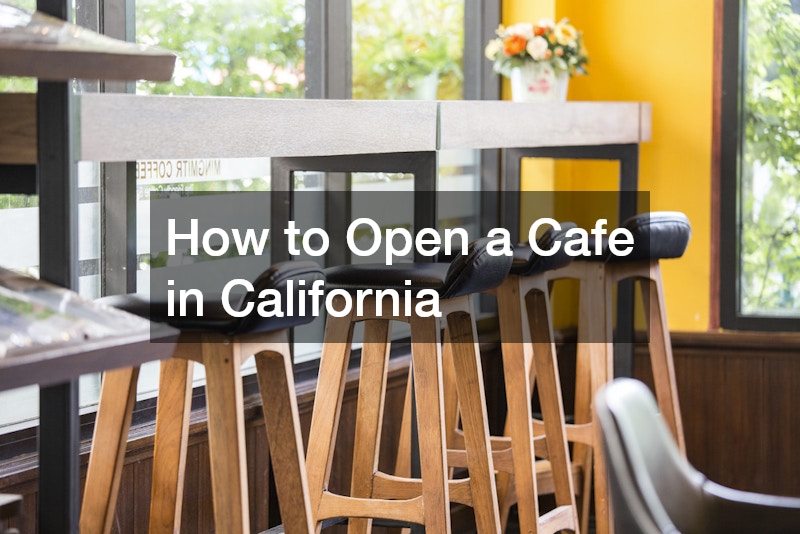Opening a cafe in California can be a rewarding endeavor, offering the opportunity to create a community hub while capitalizing on the state’s thriving food and beverage culture. However, the process involves several critical steps that require careful planning and execution. California’s unique business environment, including its diverse population and regulatory landscape, presents both challenges and opportunities for aspiring cafe owners. Successfully navigating these aspects can help you establish a thriving cafe that attracts both locals and tourists. From choosing the right location to understanding legal requirements, each phase is essential in ensuring your cafe’s long-term success.
As you begin learning how to open a cafe in California, it’s vital to take the time to thoroughly research the market and local business trends. California is home to a wide variety of tastes and dining preferences, so understanding your target market is crucial. In addition, ensuring you have a clear concept and well-structured business plan will help streamline the process as you move forward. This guide will explore several key considerations to help you open a successful cafe in the Golden State.
Researching Local Market Trends
Before opening a cafe in California, researching local market trends is a critical first step. Understanding the preferences and habits of the community where you plan to open your cafe is essential to creating a menu, atmosphere, and branding strategy that resonates with customers. Consider factors like the area’s demographics, the popularity of different cuisines or coffee styles, and even the current competition. Taking the time to study how cafes operate in various neighborhoods can provide valuable insights into what works and what doesn’t. The goal is to tailor your cafe concept to the local market in a way that sets you apart from competitors while meeting customer demands.
For example, if you plan to open a cafe in an area undergoing redevelopment, you may need to consider hiring a construction waste cleanup service to prepare the site for your business. In some cases, construction projects can present an opportunity to align your cafe with the area’s growth by tapping into new customer bases or emerging dining trends. Adapting your cafe’s offerings to reflect local tastes, such as offering plant-based menu options in health-conscious regions, can further help you stand out and thrive.
Securing the Ideal Location

Securing the right location is one of the most critical decisions when figuring out how to open a cafe in California. The location of your cafe will influence foot traffic, customer accessibility, and the overall vibe of your business. High-traffic areas, such as downtown districts or near shopping centers, can attract more customers, but they often come with higher rental costs. Alternatively, you might opt for a quieter neighborhood that caters to a specific community demographic. Consider factors such as proximity to public transportation, parking availability, and the competitive landscape in the area.
If your chosen location was previously used for a different type of business, you might need to renovate or reconfigure the space. This could involve pallet racking installers if you need to restructure storage areas for your cafe supplies. A well-designed and efficient layout not only improves the workflow for your staff but also creates a welcoming atmosphere for your customers. By securing a prime location and tailoring the space to your cafe’s needs, you can create an inviting environment that encourages repeat visits while keeping operational efficiency in mind.
Understanding California Health Regulations
When learning how to open a cafe in California, understanding the state’s health regulations is an essential step to ensuring your business runs smoothly and stays compliant with local laws. California has strict guidelines regarding food safety, sanitation, and hygiene, which cafe owners must follow to avoid penalties and protect their customers. These regulations cover everything from food handling procedures and kitchen cleanliness to waste management and staff training. Being well-versed in these rules before you open will help prevent delays during inspections and ensure that your cafe meets all health code standards from day one.
For instance, if you’re renovating an older building for your cafe, you might need to work with demolition companies to remove outdated or non-compliant features, such as old plumbing or improper ventilation systems. Ensuring that your kitchen, dining areas, and restrooms adhere to California’s health codes can be a complex process, but it is vital for gaining the necessary permits to operate. By addressing these regulations early in your planning, you can avoid costly surprises later and keep your focus on delivering excellent food and service to your customers.
Developing a Business Plan

A comprehensive business plan is a cornerstone of success when figuring out how to open a cafe in California. This document outlines your cafe’s concept, financial projections, target audience, and marketing strategy, serving as a roadmap for your business’s future. A well-thought-out business plan is not only useful for guiding your decisions but also for securing funding from investors or lenders. It should cover every aspect of the business, including startup costs, expected revenue, and an analysis of competitors in your chosen location. In addition, it helps you outline your growth goals and how you intend to meet them over time.
If your cafe venture involves partnership agreements, securing financing, or leasing contracts, it may be wise to consult a lawyer office for legal advice. Ensuring that all your agreements are legally sound and that your business is protected can prevent future disputes or financial setbacks. By combining a solid business plan with sound legal counsel, you lay the groundwork for a successful cafe that can weather potential challenges and thrive in the competitive California market.
Acquiring Necessary Permits and Licenses
Acquiring the necessary permits and licenses is a crucial step in how to open a cafe in California. California has specific regulations for food establishments, which require you to obtain various permits before opening your doors. These may include health permits, food handler certifications, a business license, and any local permits for construction or signage. Additionally, depending on your cafe’s offerings, you may need special licenses for serving alcohol or outdoor seating areas. Getting these in order early in the process ensures that your cafe complies with state and local laws and avoids costly fines or delays.
For instance, if you’re planning to add a parking lot for your cafe, you might need to work with parking lot line striping services to ensure your parking spaces are clearly marked and ADA-compliant. This, along with adhering to zoning regulations, is essential for creating a functional and legally compliant space. Acquiring the right permits not only keeps your cafe running smoothly but also builds trust with customers who expect a safe, legally-operating establishment.
Designing the Cafe Layout and Ambience

The layout and ambiance of your cafe play a significant role in shaping the customer experience, and they are essential components to consider when learning how to open a cafe in California. A well-designed space should reflect your brand’s identity and make customers feel welcome while also being functional for your staff. Consider the flow of traffic, seating arrangements, lighting, and decor. Whether you aim for a cozy, rustic atmosphere or a sleek, modern vibe, your cafe’s design will influence how customers perceive your business and how long they stay. A comfortable, inviting environment encourages repeat visits and word-of-mouth referrals.
To bring your vision to life, you’ll need to source the right building supplies that align with your cafe’s design goals. For example, if you’re creating an eco-friendly space, you might choose sustainable materials like reclaimed wood for countertops and furniture. The right combination of materials and design elements can enhance both the aesthetics and functionality of your cafe. By focusing on creating an appealing atmosphere and carefully selecting building supplies, you ensure that your cafe stands out in California’s competitive market and draws customers who enjoy the unique ambiance.
Sourcing High-Quality Ingredients
Sourcing high-quality ingredients is crucial when considering how to open a cafe in California, where customers tend to be discerning about the quality and origin of their food. Whether your cafe focuses on locally sourced products, organic offerings, or specialty items, the ingredients you use will significantly affect your menu and customer satisfaction. Establishing relationships with trusted suppliers and farmers ensures that you consistently provide fresh, high-quality items that align with your cafe’s concept. This not only elevates the flavor of your offerings but also helps build a reputation for quality, which can attract loyal patrons.
If your cafe involves a complex lease or purchase agreement for its location, consulting with a real estate attorney is a smart move. They can ensure your agreements are clear and favorable, leaving you free to focus on building relationships with suppliers and crafting an exceptional menu. By securing both quality ingredients and a solid real estate agreement, you’ll be well-positioned to establish a cafe that resonates with health-conscious and food-savvy Californians.
Hiring and Training Your Staff

The success of your cafe hinges on the quality of your staff, making the hiring and training process a key factor in how to open a cafe in California. From baristas and cooks to servers and managers, each team member plays a role in creating a smooth and enjoyable customer experience. When hiring, look for individuals who not only have the necessary skills but also share your vision for the cafe. Proper training is equally important, as it ensures your team is familiar with the menu, understands customer service protocols, and is aligned with the cafe’s culture. A well-trained staff fosters efficiency, enhances customer satisfaction, and creates a positive work environment.
To ensure your staff has everything they need to perform at their best, consider investing in the right tools and equipment. For example, if you’re redesigning your kitchen, you might look for kitchen cabinets for sale that offer both style and functionality, providing your staff with a well-organized workspace. By focusing on hiring the right people and equipping them with the necessary tools, you’ll create a team that helps your cafe thrive and ensures a consistent, high-quality customer experience.
Promoting Your Cafe Effectively
Marketing plays a crucial role in how to open a cafe in California, especially in such a competitive and diverse market. A strong promotional strategy will help you reach potential customers and create awareness about your cafe before it even opens. This can include social media marketing, collaborations with influencers, and local advertising to build excitement around your new establishment. Offering discounts or special deals during the opening week can also drive foot traffic and encourage word-of-mouth referrals. Creating a consistent brand message through all promotional channels ensures that customers remember your cafe and become loyal patrons.
For example, partnering with a corporate catering service can help expand your reach, especially if your cafe is located near businesses or office parks. By offering catering for corporate events, meetings, or company lunches, you can introduce your cafe’s offerings to a broader audience and increase brand visibility. This type of cross-promotion not only boosts sales but also opens the door to recurring business, helping establish your cafe as a go-to spot for local professionals.
Establishing Financial Projections and Budgets
Financial planning is essential to the success of your cafe, making it a key consideration in how to open a cafe in California. Establishing realistic financial projections and budgets helps you manage costs, forecast revenue, and plan for growth. This includes determining startup expenses, such as equipment, renovations, and inventory, as well as ongoing operational costs like wages, utilities, and marketing. A clear financial plan enables you to stay on track with your spending and set measurable goals for profitability, which is especially important in the competitive cafe industry.
If your cafe requires significant renovations, such as a kitchen overhaul or interior redesign, budgeting for these improvements is critical. Working with contractors specializing in kitchen and bath remodeling can help you achieve the desired look and functionality while staying within budget. Careful financial planning, combined with smart investments in your cafe’s infrastructure, will position your business for long-term success and allow you to manage growth sustainably.
Conclusion
Opening a cafe in California is a multifaceted process that requires careful planning, creativity, and perseverance. From researching local market trends to securing the ideal location and adhering to health regulations, each step plays an important role in building a successful business. By focusing on key aspects like high-quality ingredients, staff training, and effective marketing, you can create a cafe that stands out in the crowded California food scene. Additionally, thoughtful financial planning and strategic partnerships will help ensure your cafe’s long-term growth and sustainability.
As you continue to explore how to open a cafe in California, keep in mind the importance of balancing creativity with practicality. The choices you make early on, from location to layout, will shape the customer experience and your ability to operate efficiently. With a clear vision and careful attention to detail, you can establish a thriving cafe that not only serves delicious food and coffee but also becomes a beloved part of the community.


